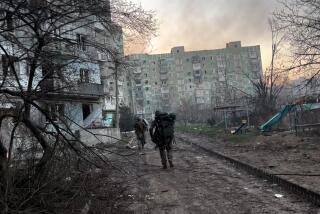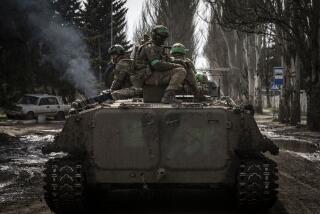Military Support Services Proved Their Worth in Supplying Victory : Logistics: The battle doctrine included the organizations necessary to keep combat units fed, armed and equipped.
- Share via
“Without supplies, neither a general nor a soldier is good for anything,” Clearchus of Sparta said in a 401 BC speech to the Greek army in Asia Minor.
Many things have changed in the 24 centuries since, but the need for supplies--if anything--is even more critical in a modern, highly technical military than it was in the days of sword and chariots.
I can still recall a 1966 briefing at II Field Force Vietnam, at which operations planners laid out to the assembled generals their grandiose scheme to conduct a multidivision operation in a rice-growing area northeast of Saigon.
Just as it ended, a pudgy quartermaster captain stood up in the back of the room and cried, “We can’t support it!”
Consternation reigned. But the captain, the 1st Logistical Command liaison officer, had them cold. The road networks and airfields could not begin to handle the tons of fuel, ammunition and supplies the operation would require.
Fifteen years later, when AirLand battle planning was in its infancy, war plans were made for deep strikes from West Germany into Poland and Czechoslovakia. It looked good on paper, until a logistician did some quick calculations and determined that there weren’t enough fuel trucks in all Europe to keep such an armored column on the move.
Failing to figure in logistical requirements long has been an operational shortcoming. The late Gen. Bruce C. Clarke said the reason the Soviet Union occupied Eastern Europe in the closing days of World War II was that the allied planners for the Normandy invasion had not planned beyond the beachhead. As a result, Gen. George S. Patton’s 3rd Army ran out of gas and ammunition halfway across Europe. While they sat and waited for resupply, the Red Army continued to roll.
The 3rd U.S. Army once again was in action, this time in the Persian Gulf, the army component of Gen. H. Norman Schwarzkopf’s Central Command. But this time they got it right. “Mobility is the true test of a supply system,” wrote military strategist B. H. Liddell Hart in 1944. In the Persian Gulf War, the supply system passed that test with flying colors.
The Army’s AirLand battle doctrine not only included combat units to close with and destroy the enemy, it had sufficient combat-support and combat-service-support units to keep those fighting units fed, resupplied, armed and equipped.
Quartermaster Corps’ Lt. Col. John E. Brown of the Army War College’s Department of Military Strategy, Plans and Operations explained how this system worked:
Within the Army’s basic fighting units--the infantry, armor and cavalry maneuver battalions, and the aviation and field artillery battalions that provide battlefield fire support--there are maintenance sections and support platoons that provided immediate logistic support. A battalion normally carries enough supplies and ammunition to last three days.
At the brigade level, behind the attacking forces, was a forward support battalion that typically consisted of a supply and service company, a maintenance company and a medical company. Further back, “Division Trains,” the support command that is part of every armored or infantry division, carried 30 days of supplies.
These supplies included food, barrier material, POL (petroleum, oil and lubricants), ammunition, PX supplies, replacement equipment, medical, spare parts and civil affairs. For mechanized and armored divisions, the tonnage can be staggering--5,000 tons of ammunition and 500,000 gallons of fuel per day.
In direct support of these divisional units were two corps support commands (COSCOMs)--the 1st COSCOM with the XVIII Airborne Corps and the 2nd COSCOM with the VII Corps. Each had a medical group and five corps support groups consisting of a maintenance battalion, quartermaster fuel and water supply battalions, supply and service battalions, transportation battalions, ordnance battalions and aviation battalions.
Reinforcing these direct support groups was the 22nd Theater Army Area Command, which carried a 60-day level of supplies.
Unlike the practice in earlier wars, there was no depot system in the Gulf theater. Supply requisitions were consolidated at divisional level and sent by computer to National Inventory Control Points in the United States, which passed them either to military depots in the United States or the manufacturers. Supplies then were pinpointed to be shipped directly to units in the field.
In the deep strike into Iraq, supplies were flown to the front by Army helicopters and Air Force C-130 transports. Tanks, for example, were refueled from enormous “bladders” airlifted along the routes of advance.
The U.S. commander in the Gulf, made it clear how important this logistical system was to the success of Operation Desert Storm.
“I think it’s very, very important that I make this point,” Gen. Schwarzkopf said during a briefing at Riyadh, Saudi Arabia, on Wednesday, “and that’s these logistical bases. Not only did we move the troops out there (into the desert), but we literally moved thousands and thousands of tons of fuel, of ammunition, of spare parts, of water and food, out (to staging areas in western Saudi Arabia), because we wanted enough supplies on hand so that . . . if we got into a slugfest battle . . . we’d have enough supplies to last 60 days.
“I can’t give credit enough to the logisticians and the transporters who were able to pull this off,” Schwarzkopf added, “to the superb support we had from the Saudi government (which, among other things, provided all the POL), the literally thousands of drivers, really, of every national origin, who helped us in this move out here.”
When a Roman general, returning in victory, rode in triumph through the streets of Rome, a slave riding with him would whisper in his ear, “Remember, you are but a mere mortal.”
And when Gen. Schwarzkopf returns for his triumph, with him should be his chief of logistics, Lt. Gen. William G. (Gus) Pagonis, whispering in his ear, “Remember, I’m the guy who got you there.”
Of course, Gen. Schwarzkopf already knows that. But it would be an object lesson to the rest of the military not to forget, as the 19th-Century strategist Baron Antoine Henri Jomini put it: “Strategy decides where to act, logistics brings the troops to that point.”
More to Read
Sign up for Essential California
The most important California stories and recommendations in your inbox every morning.
You may occasionally receive promotional content from the Los Angeles Times.










